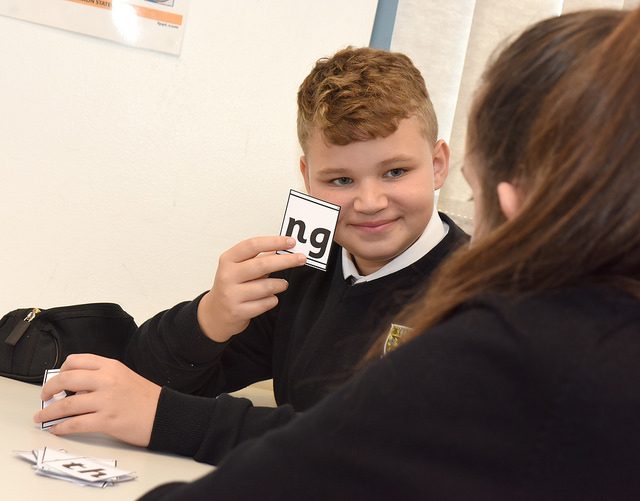Skip to content

Pupils offered the following comments about being in the Fresh Start reading class at Graeme High School:
At first I thought it was like being a primary pupil but now I am glad because now I can read like everyone else.
When I came here I was scared because I didn’t know how to read that much. So then I sound talk the word and then I know the word.
I love reading.
I was scared because all my friends could read and I couldn’t. I thought I was dumb, stupid because I couldn’t read. I hated myself. People said I was born silly and it got to me. I didn’t want to come to high school because people would know BUT everyone liked me and I came to this class and now I can read. Don’t let people get you down because you are going to be amazing when you get older and the bullies are nothing.
What does it take to get pupils to talk about reading like this? Caroline Harper, faculty head of English at Graeme HS shares the process and impact in her report below.
PEF Literacy – Read Write Inc
We introduced Fresh Start at Graeme High School through finding out about strong results from colleagues in Dundee. We decided to introduce it to S1, S2 and S3 in the first year as the potential for this to transform pupils’ life chances was considerable. Pupils who had gaps in their learning which needed to be filled were selected for the scheme.
It was a highly structured course. All English, Support for Learning teachers and Support for Learning staff were trained in the methodology. There was substantial investment in resources. In addition, we benefited from two development days, when a trainer came in to observe us teaching and offer feedback about how effectively we were implementing the course.

Read Write Inc assessments
Pupils were assessed every six weeks using the Read Write Inc assessment. This involved recognising ‘speed sounds’ correctly and reading a short passage. There were seven passages and pupils had to read them with few errors and in a reasonable time (very slow reading makes comprehension unlikely).
All pupils made progress in these assessments. Records have been kept and every pupil has made some progress, many completing the 33 module course in fewer than 33 weeks.
Closing the Gap evidence
Although we could see from the assessments that pupils could now read passages that they could not read a few weeks ago, we did not know whether we had ‘closed the gap’ as their peers would also have been improving their reading skills in the course of the session. To check this, we used the Test of Word Reading Efficiency, an index based test (100 representing average performance) to allow us to see whether they had improved relative to their peers. For example, a score of 70 (poor) followed by one of 80 (below average) six months later, would show that they had improved relative to their peers. 
We tested their progress over a six month interval using the Test of Word Reading Efficiency. It was in two parts – the Sight Word Efficiency test where pupils had to recognise and read words as quickly as they could and the Phonemic Decoding Efficiency test where pupils had to use their phonemic knowledge to read a list of non-words. The raw scores could then be correlated with their age, which would give a scaled score. This scaled score allowed us to see where they were in relation to their peers. This meant that any improvement was an improvement relative to their peers – which meant that we had made some progress in ‘closing the gap’.
S2 group
According to the form a margin of difference in the two scaled scores of more than 10 meant that we could be 95% confident that the improvement was not down to chance. However, a difference of less than 5 could be attributed to chance. A difference of 6 gave a confidence measure of 70%. A difference of 5 gave a confidence measure of 60%.
For 8 out of 13 pupils in this group, the difference in the phonemics score was 5 or greater and for two it was over 10.
S3 group 
For two pupils, the results were positive with a gain of 6 and 7 points in the phonemic decoding test. This gives a confidence level of 80% and 85% respectively that this improvement was not due to chance but represented an improvement in their skills. Of the two pupils who showed significant improvement, one had made a year’s improvement and the other three year’s improvement in decoding skills.
S1 group
This was a large group of 23 pupils. For seven of these pupils there was a clear improvement in either their phonemics or their sight word recognition or both.
 Reading Age improvements
Reading Age improvements
The TOWRE-2 authors state that they are confident about the reliability of the scaled scores in proving improved performance but are less convinced about their reading age data. However, it is helpful to know that, for pupils at this stage, a difference of 6 in the scaled score usually equates to a year’s progress (in six months) and a 7 point difference usually equates to three year’s progress (in six months).
When asked to capture simple words which described their experience in the Fresh Start Class, pupils said:
‘never give up’, ‘it was fun’, ‘fascinated’, ‘excited’, ‘extraordinary’, ‘amazing’, ‘happy’, ‘grateful,’ ‘awesome’





 Reading Age improvements
Reading Age improvements